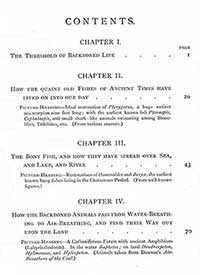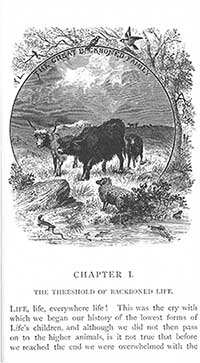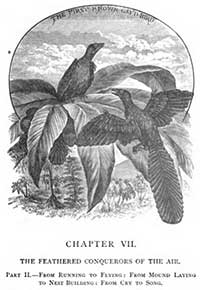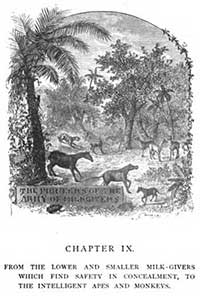
Representing Evolution: A Case Study
in Visual Narrative
- Richard Somerset
_______________________________

Fig. 6. A. Buckley, Winners in Life's
Race, 1882 

Fig. 7. Th. Carreras, “The Great Backboned
Family”, Winners in Life’s Race, 1882 

Fig. 8. Th. Carreras, “The First Known
Land Bird”, Winners in Life's Race, 1882 

Fig. 9. Th. Carreras, “The Pionneers of
the Army of the Milkgivers”, Winners in
Life’s Race, 1882 
Buckley’s core narrative is thus derived from typology not from chronology; and it uses an implied hierarchy within that typology as a way of hinting at an implied chronology of emergence that closely follows the more evident path from lower to higher types. Structural hierarchy was a far more self-evident notion to Victorians than variability in natural categories would have been! By centring her account of the history of nature around an organicised hierarchy of physical and moral status, Buckley was talking to her audience in terms that would make sense for them, as the best way to accustom them to the highly unintuitive idea that the barriers between natural categories were not in fact fixed, but might in a sense be crossed. The work of consolidating this difficult novelty would be largely carried by a distinct set of images that Buckley called her “picture headings” since they were placed at the head of each chapter, and which are of central interest to us here. The rest of our analysis will focus on their construction and their broader role in the text.
As the name Buckley gave them perhaps suggests, the ‘picture headings' did not really take an active place within the text; they are in fact rarely referred to in the text and when they are, it is to mention some specimen depicted there rather than to remark upon the significance of the scene as a whole. To the casual reader, then, they may seem to be little more than meta-textual embellishments. Their formal significance in the structure of the book becomes clear only when one notices that the table of contents includes, along with the title of each chapter, a description of the associated ‘picture heading' detailing the species depicted – almost always extinct species – and mentioning, where appropriate, the pictorial sources used (see fig. 6). The descriptions also approximately situate each scene in geological time, thus asserting (in a minimalistic way) the sequential character of the series. It is also significant that the ‘picture headings' are prominently mentioned in the brief preface, where Buckley calls them “geological restorations”, and pointedly claims for herself the responsibility for their design, as well as asserting the originality of at least some [6].
The first chapter heading is the only one that does not participate in the chronological sequence outlined in the table of contents, also the only one to feature exclusively modern species (fig. 7). All the main vertebrate classes appear, readable in sequence moving more or less from bottom to top: fish, amphibians, reptiles, small and large mammals, and birds. The internal title tells us that the illustration depicts “The Great Backboned Family”, while the textual heading, just below the ‘picture heading' on the same page, announces the theme of the chapter as “The Threshold of Backboned Life”. Nothing depicted in this scene is explicitly mentioned in the text of the ensuing chapter; yet the scene’s dynamic plays an important role in giving body to the outlook that Buckley sought to promote. Clearly the point here is the establishment of the typological basis to her account.
Perhaps the most curious and the most striking feature of the illustration is the use of what we might call an ‘internal frame' – a device that reappears in seven of the eleven remaining ‘picture headings'. The central figures of the illustration are partly surrounded by an incomplete circular frame whose status as a formal division between distinct zones varies according to the elements we consider. At the top of the picture, the separation is absolute and there is no possible continuity between the landscapes represented on either side of the internal frame. But as we go down the page, the distinction dissolves, the dividing line disappears and a space of continuity emerges where the divide ceases to exist – the transition is disguised by a rock on one side, a bush on the other, and the space created is partly occupied by a sheep. The status of the frame as a conventional device is also humorously called into question by the fact that one of the birds is perched on it, and its tail even slightly obscures the other apparently conventional element, the picture’s title which follows the curve of the frame. We can thus see that the illustration is designed to materialise – and to some extent even to naturalise – the concept of the limit, in the form of the internal frame; and also its opposite, the threshold, the space where the frame disappears and the passage from one space into another becomes possible.
Clearly, this scene is not intended as a naturalistic depiction of a ‘slice of time', as Figuier’s were. On the contrary, it translates a complex idea: that Nature’s categories appear fixed, but when properly viewed turn out in fact to be porous. Beyond the conventions of fixed taxonomical names, we must learn to understand that nature’s reality is more fluid. This picture heading is thus an attempt to represent the vital dynamic that balances stability and change in the natural economy.
Although the first picture heading has a special status as the most abstract of the illustrations, the more referential ones that follow continue to deploy the same set of visual metaphors. In some cases, the limit-crossing theme appears in purely conventional terms, similar to those of the first scene. The picture heading for chapter seven, for example, has a similar incomplete internal frame, and depicts a large bird about to land on a tree growing from the external space below into the centre of a distinct space within the internal frame (fig. 8). In others, such as that which introduces chapter nine, the frame is not internal to the scene, but as if to compensate, it is particularly strongly traversed and colonised by elements that would not conventionally interact with it: the palm tree overflowing on the left, and the climbing vine on the right (fig. 9). In addition, the scene’s title now also appears in quasi-naturalistic form, as if it were an object within the scene, obscuring a part of the animal standing behind. It thus acts as another kind of ‘internal framing device', not creating a threshold to traverse as before, but merely marking out a distinct space for a distinct type. In this case a small creature, the marsupial Echidna, appears alone in front of the title-block, duly separated off from the ‘higher' mammals by this semi-naturalised intrusion [7].
[6] “The geological restorations given as picture-headings (some of which are here attempted, I believe, for the first time) have been most carefully considered, though the exact forms of such strange and extinct animals must necessarily be conjectural. My thanks are due to the artist; Mr. Carrerras, jun., for the patience and care with which he has followed my instructions regarding them...” (WLR, vii).
[7] Buckley’s table-of-contents description calls it a “hedgehog”, but a very similar specimen illustrated in the previous chapter is identified as the marsupial Echidna (WLR, 188, 190).


